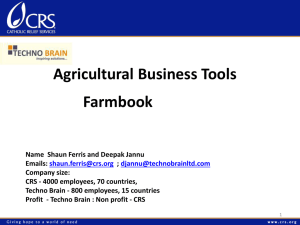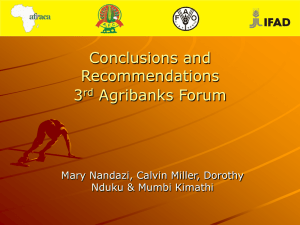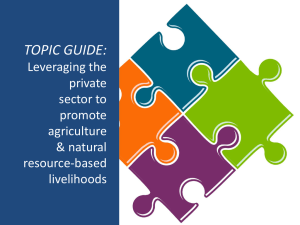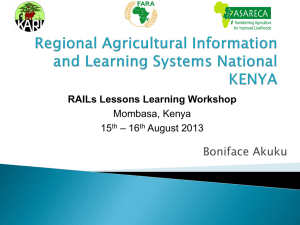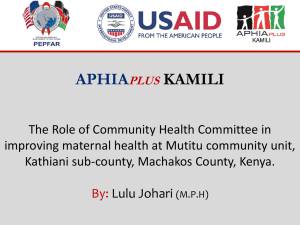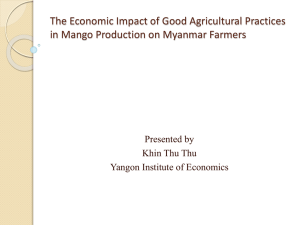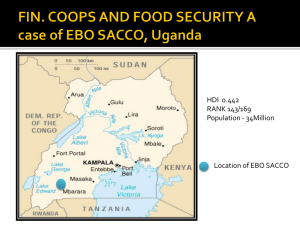SFSA Presentation - Syngenta Foundation For Sustainable Agriculture
advertisement
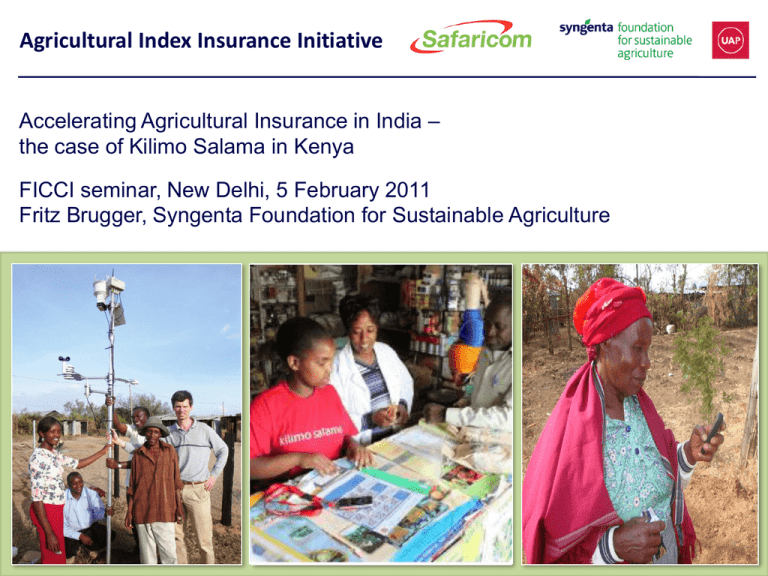
Agricultural Index Insurance Initiative Accelerating Agricultural Insurance in India – the case of Kilimo Salama in Kenya FICCI seminar, New Delhi, 5 February 2011 Fritz Brugger, Syngenta Foundation for Sustainable Agriculture Kilimo Salama – Overview • Background – Kenya – Insurance situation – Partners • Challenges – Distribution – Literacy – Affordability • Success factors – Role of technology – Product design – Added value services – Private sector partnerships Agriculture Insurance Situation in Kenya Insurance setup differs from India in several aspects: • Product availability: – Multi-peril crop insurance: product is in the Market, available only for large scale farmers (500+ acres) 9.6 mn Kenyans involved in smallholder agriculture (FAO CountrySTAT (2008)) – Index insurance introduced in 2009, still in pilot stage • Role of government: – Government plays no active role in providing agricultural insurance: – No subsidies available – No mandatory insurance linked to credit – Limited availability of historic weather data and AWS • Access to agricultural finance – Limited because of magnitude of risk Kilimo Salama – Partners • Syngenta Foundation for Sustainable Agriculture – Is a not for profit organisation with the mandate to support smallholder famers by increasing productivity, improving access to markets, and mitigating farming risks. – Syngenta Foundation has been established by Syngenta International AG, an agro chemical and seeds company that works in over 90 countries and has 26,000 employees. • UAP Insurance Limited – a leading Kenyan insurance and financial services company with a presence in Kenya, Uganda and Southern Sudan. – In March 2009 UAP insurance started a pilot to offer insurance to small farmers in Laikipia district and is now looking to expand this. • Safaricom – Largest telecom operator in Kenya. Pioneered mobile payment service M-Pesa with currently 9.4 mn accounts. Current status of pilot and project goals Insurance products are only sustainable if they can reach scale We currently insure 12,000 farmers in 5 areas in Kenya We aim to offer insurance to farmers in all agricultural areas in Kenya by 2012 This will require investment in: The weather station network from 30 300 A significant investment in financial education 5 Agroclimatic zones 6 Challenges to index insurance growth in Kenya Challenges Responses Weather data historic and AWS Setting up network Distribution no branch network in rural areas Use of new distribution channels Transaction cost high number of small policies Use of technology Affordability high premium due to high risk Product design Partnerships Added value services Financial literacy low insurance literacy low trust in insurance Training Added value services Automated Weather stations • Setting up AWS network • Rainfall, wind, temperature, humidity, radiation, leaf wettness • Remote monitoring of weather station operations • Security and operations • Preparing private company • Coordination with Kenya Met Dept Overcoming the Distribution bottleneck • Agrovets: Closest allies of farmers: Farming advice, Loans, Business success • 8’000+ agrovet shops across Kenya’s farming areas – Small shops, Very busy around planting (up to 70% of sales in two month) • Challenges – Insurance is not their core product - but has a positive impact on their business. – Insurance registration process must be fast and convenient 9 Mobile Technology – Reducing Transaction Cost Distr Mobile Platform MIS CRM Empower stockists Policy management Premium collection Claims payment • Training monitoring Client communication • Added value services Kilimo Salama Mobile Application Agrovets are given a mobile phone with the Kilimo Salama application. When a farmer wishes to purchase insurance the stockist starts the Kilimo Salama application and registers the farmer in a four-step process Farmer confirmation and payout The insurance policy is automatically created on the server and the farmer receives an instant confirmation of his/her insurance coverage via SMS. Payouts: Automated decision on payouts Payouts to all farmers under the same weather station Payouts directly to the farmer’s phone (M-Pesa) Making Marketing and Training more effective 1. Field staff holds the first training 2. At the end of the training the attending famer send keywordsms to server T101 3. All farmers are registered into the database linked to an area and trainer 4. Follow up information can be requested by text or via a helpline. 5. Future trainings and simple extension information via mass SMS. 6. When the farmer buys the product she uses her phone number and she is recognised as linked to t101 = Joseph. 13 Cut costs on follow up training and mobilisation Real time monitoring and rewarding of field personnel Product design – removing the entry barrier Entry barriers: lack of financial literacy, lack of trust • Create “entry level product” that allows farmers to “try out” insurance • Pay as you go • Over time, farmer can move towards higher level products coverage • Expected value of harvest Value of input + Labor Value of Inputs premium Affordability – partnership with input suppliers • Risk is high and therefore the premium for a reasonable risk coverage is high and for many farmers beyond their affordability • Partnerships with the private sector as sustainable alternatives for subsidies • Input companies have interest in success of farmers Partnership with private sector suppliers 50% Agrocompany 50% Farmer Premium Affordability – added value services Agricultural Index Insurance Initiative Thank you! fritz.brugger@syngenta.com Reducing transaction cost: Weather index based insurance • Index model – Relation weather conditions & crop growth using agronomic models – Historic weather data used for pricing risk • Automated weather station measures conditions • If weather station shows loss, then all insured farmers are paid, irrespective of onfarm loss • No farm visits = low transaction costs Automated Weather stations • Send data every 15 minutes to central server over GPRS network • Store and resend data in case network is down • Solar powered • Remote monitoring of weather station operations • Most weather stations are placed on public ground (schools) • Data are also provided to local schools, used in geography classes

